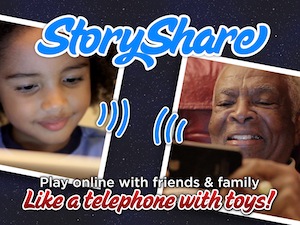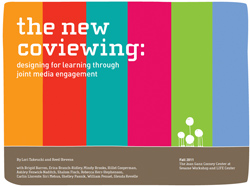Avast! Today marks an exciting day for our hornswoggling crew here at Launchpad Toys: Toontastic Jr. Pirates is LIVE in the App Store for iPhone and iPad! With 3 million cartoons created in over 150 countries, our first app – Toontastic – has been a great success for kids ages 6-12. Now, with the launch of Toontastic Jr. and our new StoryShare platform for online, creative Co-Play, little brothers and sisters as young as 3 years old can create their own cartoons collaboratively in real-time with friends and family anywhere in the world.
Designing for Co-Play
As most parents can attest, getting a young child to talk on the telephone or Skype can be quite an endeavor — abstraction and lack of context makes it challenging to hold kids’ attention. Yet, sit that child down with a toy box of dolls or action figures and you’ll find yourself awash in a sea of chatter. Kids communicate naturally through imaginative play, learning about the world around them through creative collaboration with peers and family, using toys as contextual catalysts for conversation.
In designing for Co-Play, our challenge is conceptually simple, but technically complex: empower kids and their families to create and communicate as naturally and fluidly as they would playing with a box of LEGOs. The Cooney Center’s recent report on Co-Viewing outlined some great tips for this, three of which we found particularly inspiring in creating Toontastic Jr.’s StoryShare feature — we hope they serve you well too!
 Build Synchronous, Shared Workspaces
Build Synchronous, Shared Workspaces
With sites like Facebook and YouTube, “sharing” has become synonymous with posting and uploading. Yet as our 3-year-old play-testers reminded us, we’d forgotten about the original form of sharing — not just sharing what you create, but sharing in the creation process itself. Co-Play, our first foray into “social” media as kids, requires real-time collaboration, open chat, and shared workspacesthrough which kids can communicate, imagine, and create freely. With Toontastic Jr., families can talk, play, and tell their own stories in a shared creation space — recording their voices and moving characters onscreen from thousands of miles away, just as they would sitting together on the living room carpet.- Empower Kids through Mutual Engagement
In engineering a shared workspace, it’s tempting to simplify development by limiting interface control to one user, but true collaboration requires equal access and active participation by everyone involved. This is why “leader/follower” models like online co-reading fall short of the mark so often. Toontastic Jr.’s interface is built for universal accessibility — anyone can pick a scene, move a character, or choose a song at any time. We’ve found this offers a great balance — elders generally take the lead the first time through the app, but kids assert themselves in subsequent scenes and sessions. Once this happens, our biggest challenge was ensuring both parties were on the same page creatively. Turns out it’s pretty hard to tell a story together without time to sync up beforehand. For this reason (and to help kids with “blank canvas anxiety”), we created “Story Starters” that play before each scene. These 10-15 second video clips not only set the stage for storytellers, but also create a window of time to plan the upcoming adventure prior to recording. - Inspire Creative Collaboration Through Toys, Not Games
From Madden “Social” to Call of Duty, there’s no shortage of multiplayer games in the market today. Unfortunately, very few live up to the high standards of Co-Play for one simple reason: they’re games, not toys. Games are scripted experiences defined by game designers. Toys, on the other hand, are paintbrushes that inspire kids to create their own imaginary worlds. While multiplayer games can be cooperative, they can never be truly collaborative because they don’t allow players to generate their own ideas. With digital toys, families can work together to create and realize their collective imaginations.
Thanks to incredible advancements in mobile platforms and years of study by researchers and groups like the Cooney Center, the remarkable promise of Co-Play is finally within reach. As developers, it’s now our responsibility to take the last step – to imagine and create the next generation of children’s media that brings families together and enables kids to create and learn collaboratively with friends and family next door or thousands of miles away.
We ask our children to play and work collaboratively, but too easily forget that we need to do the same. Today, we hope you’ll join us in embracing digital toys to collaborate with others, that our findings will help you in your development, and that — just maybe — you’ll take a moment to play out a few high-seas adventures along the way.
Andy Russell is a toy designer and a co-founder of Launchpad Toys — creators of Toontastic, MonkeyGram, and Toontastic Jr. Inspired by the movie BIG and a lifelong obsession with small brightly colored plastic bricks, Andy is a graduate of Learning Design programs at Stanford and Northwestern and has worked for companies like Hasbro and Sony PlayStation to design playful learning experiences for kids.
Hannah Clemmons is a playful storyteller and educational technology specialist working with Launchpad Toys to build a global storytelling network for kids. Hannah is a graduate of the Early Childhood Education program at Columbia College Chicago.

